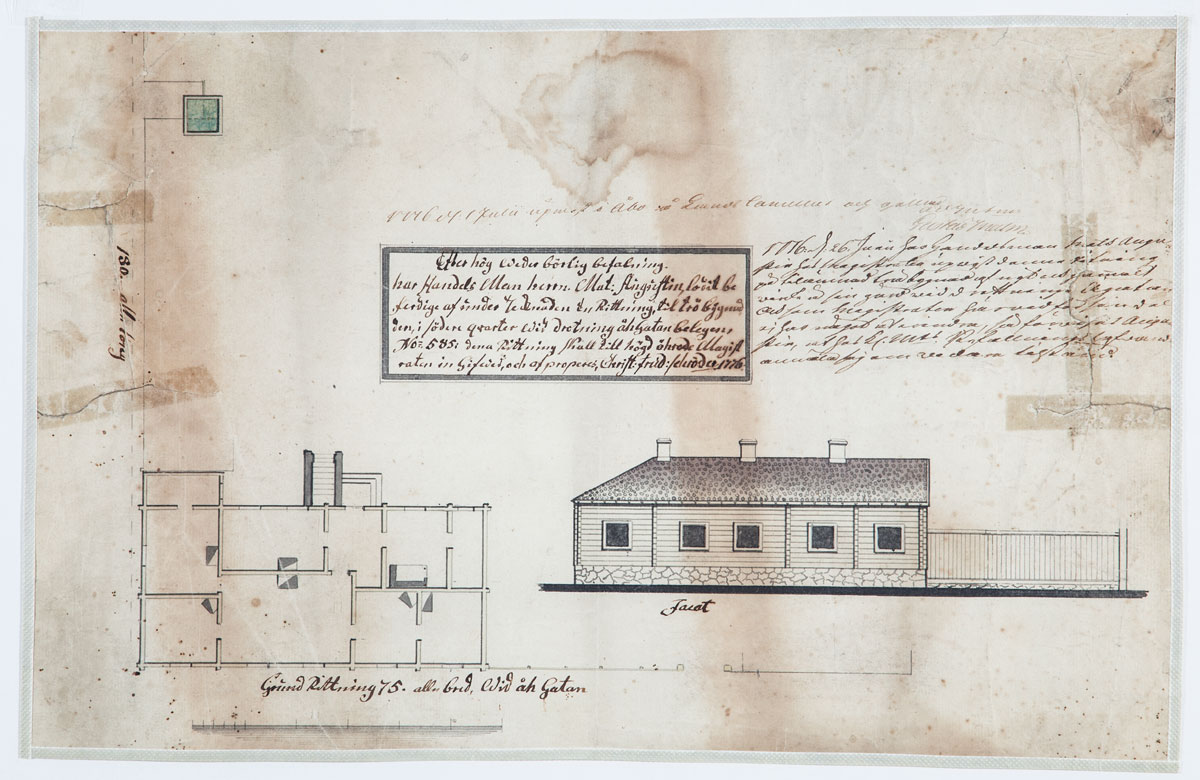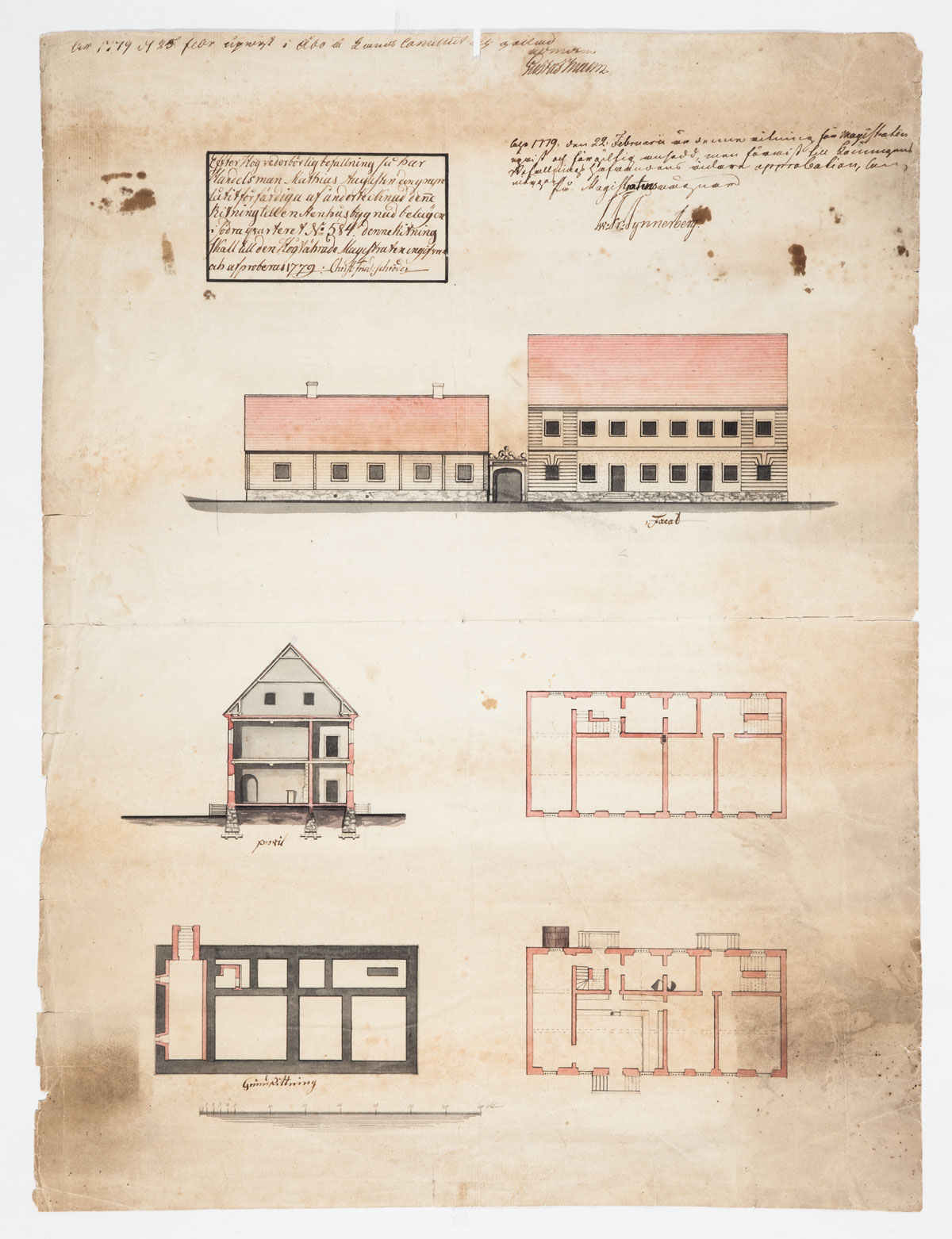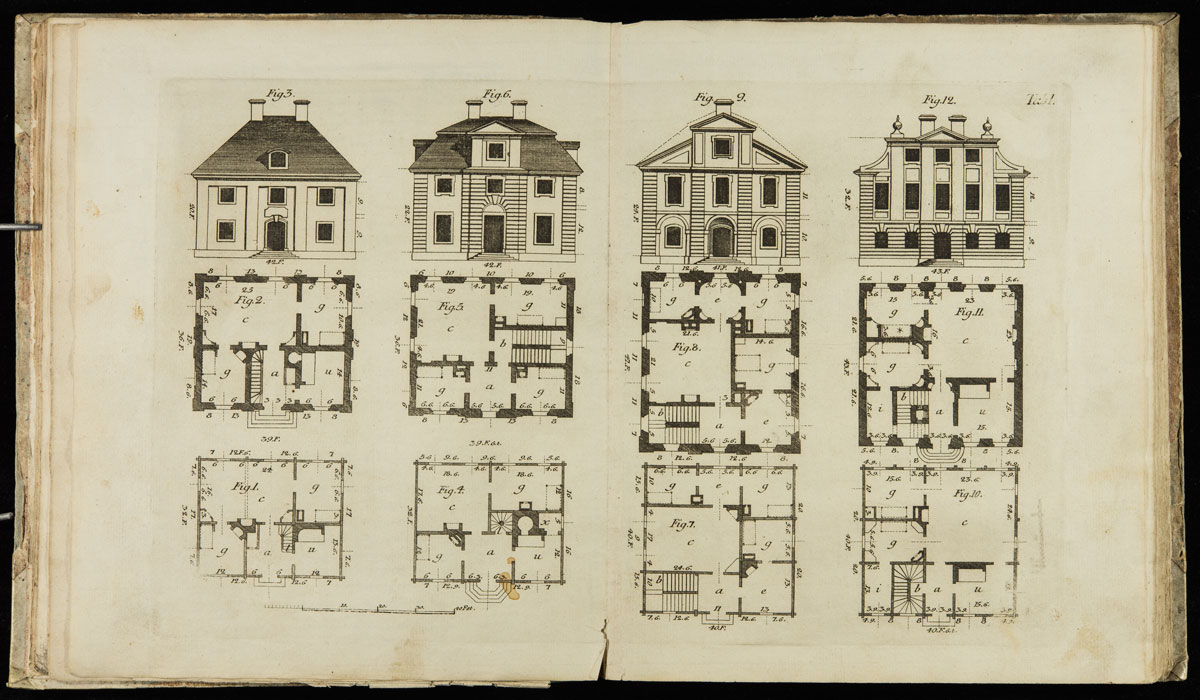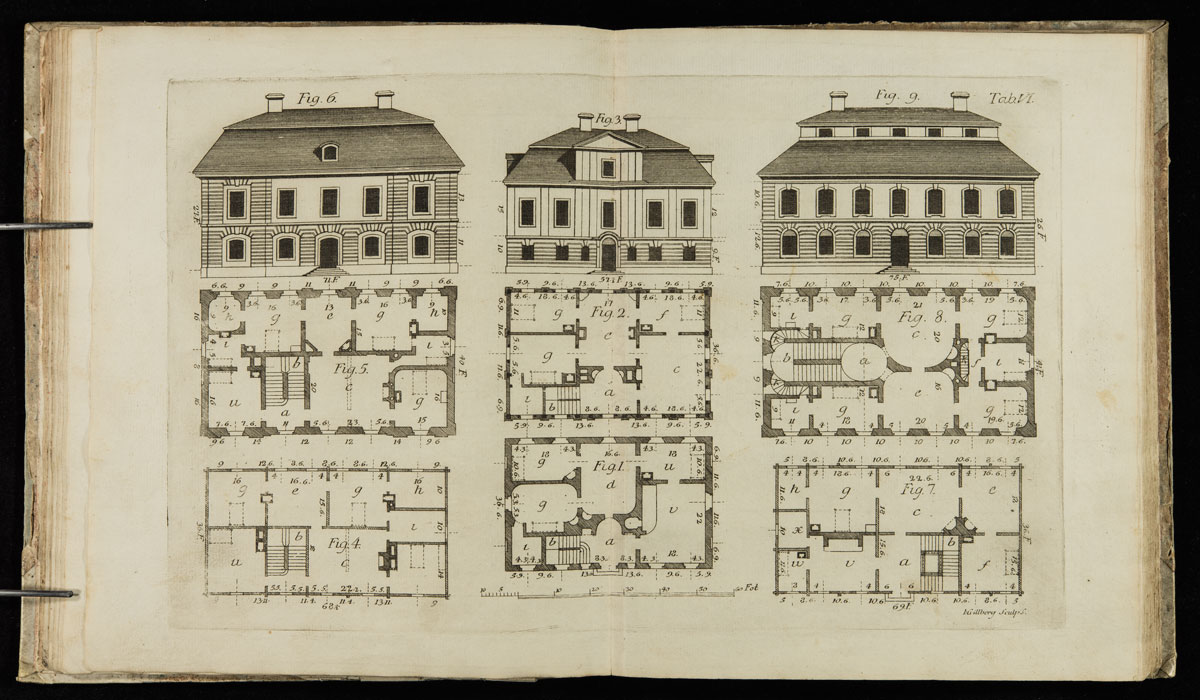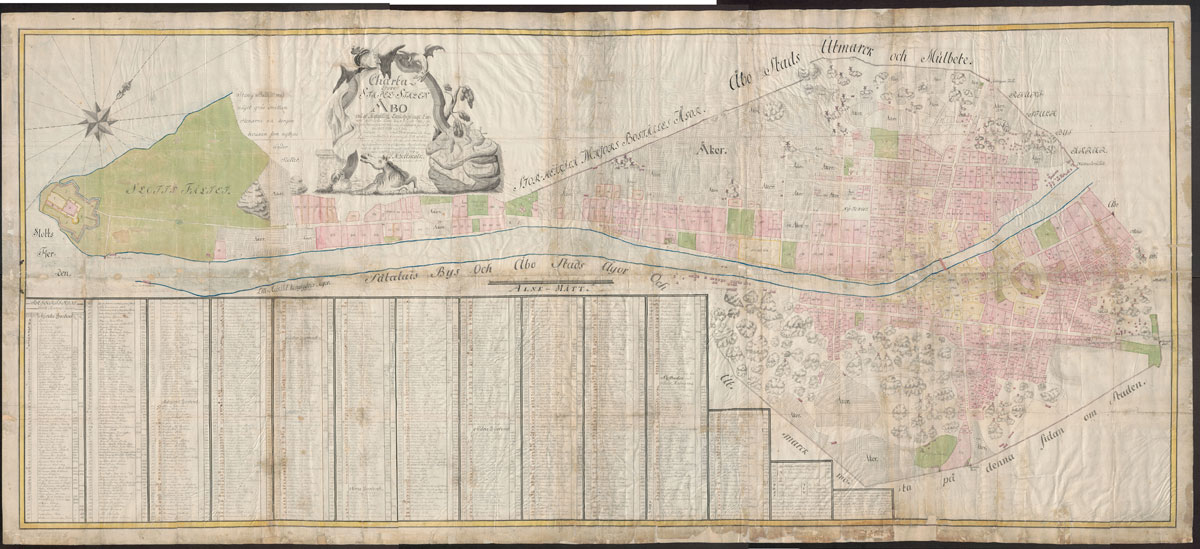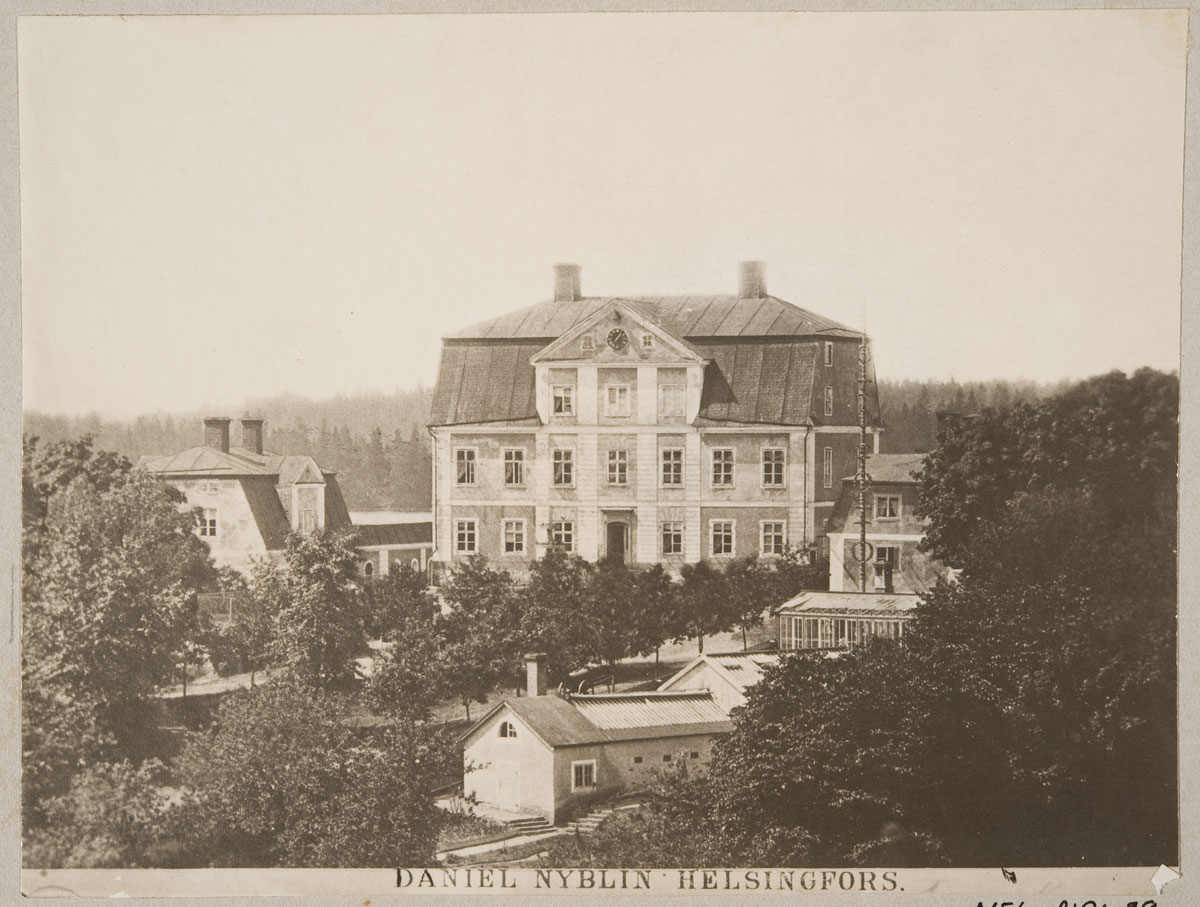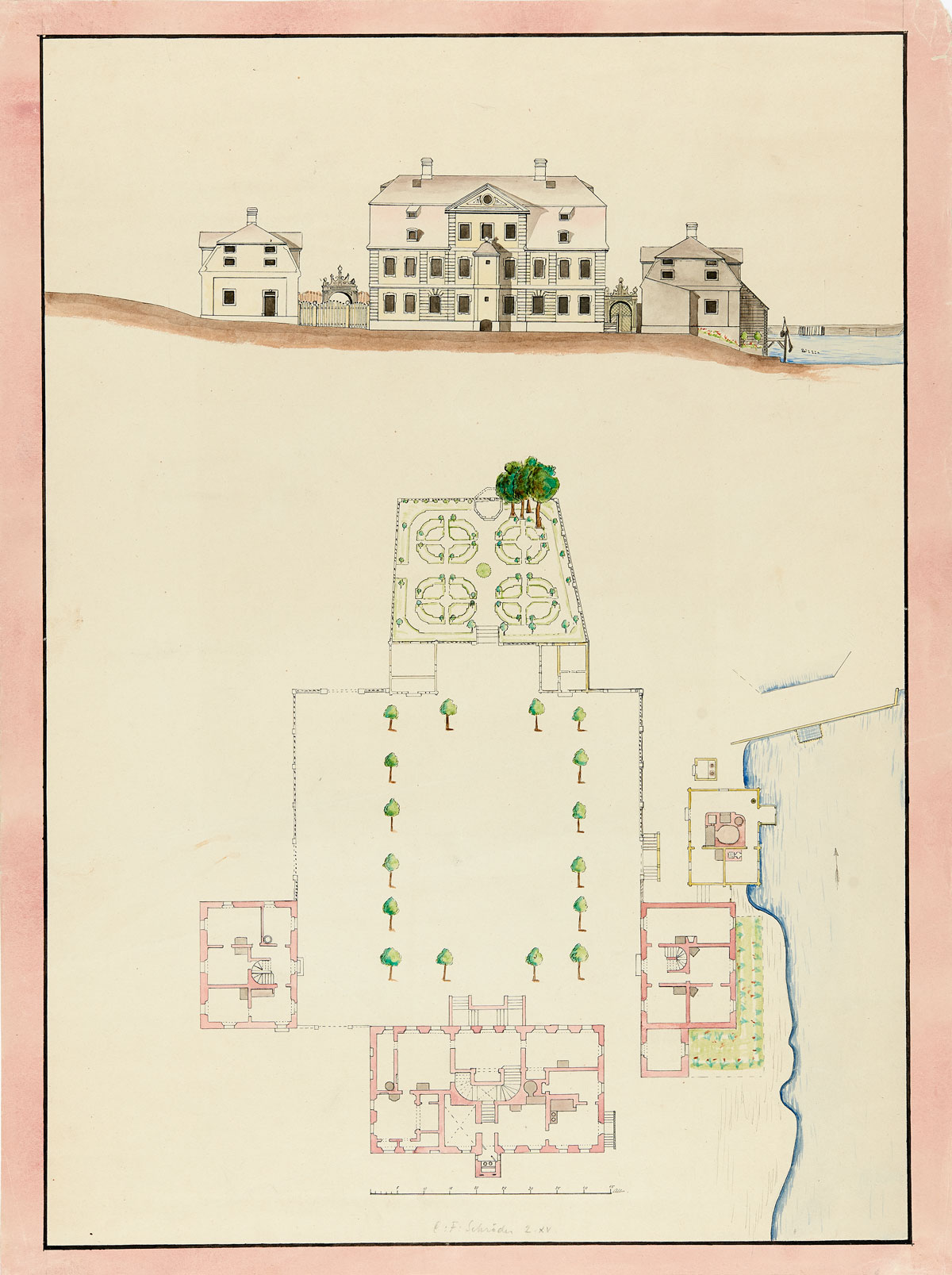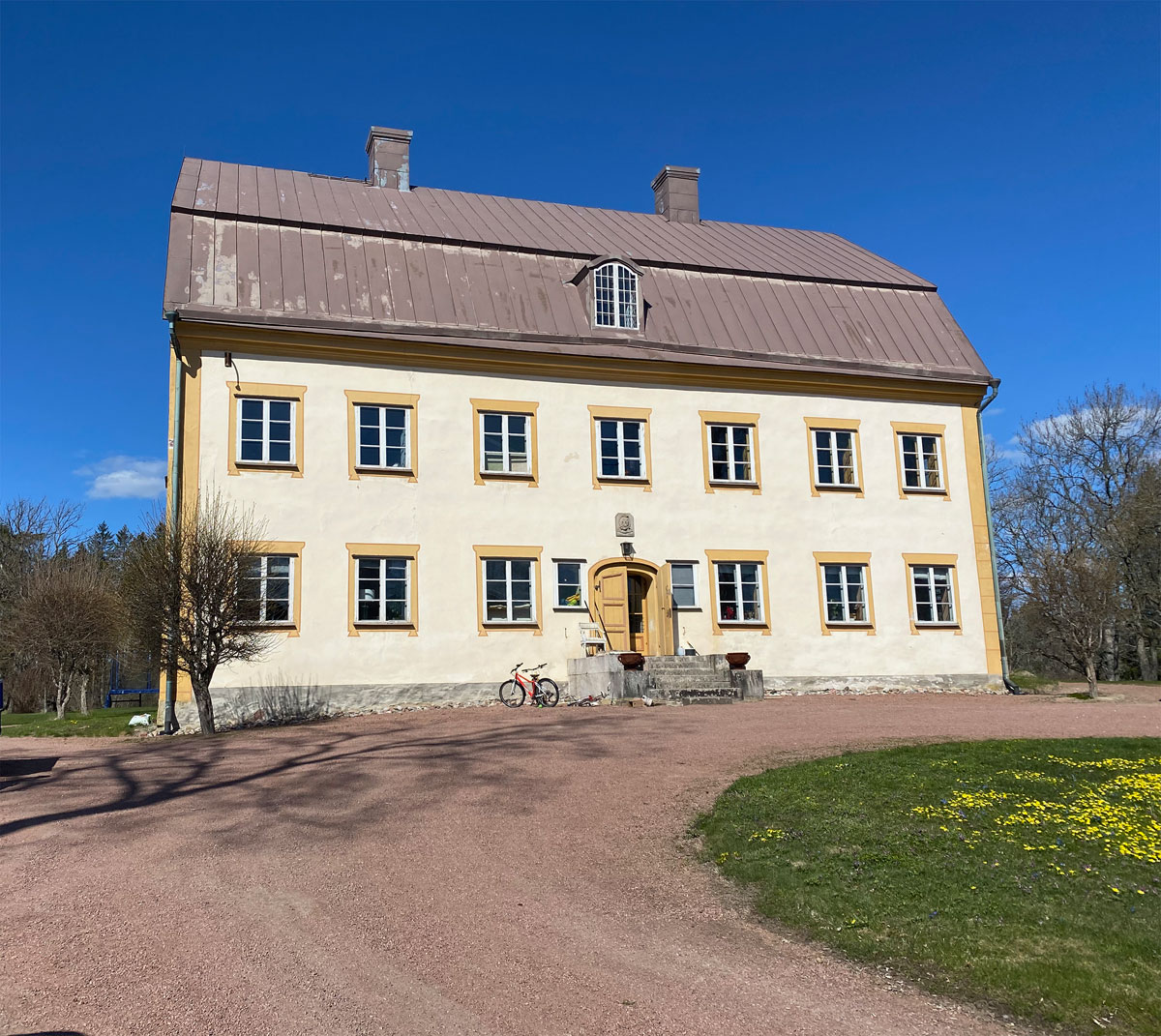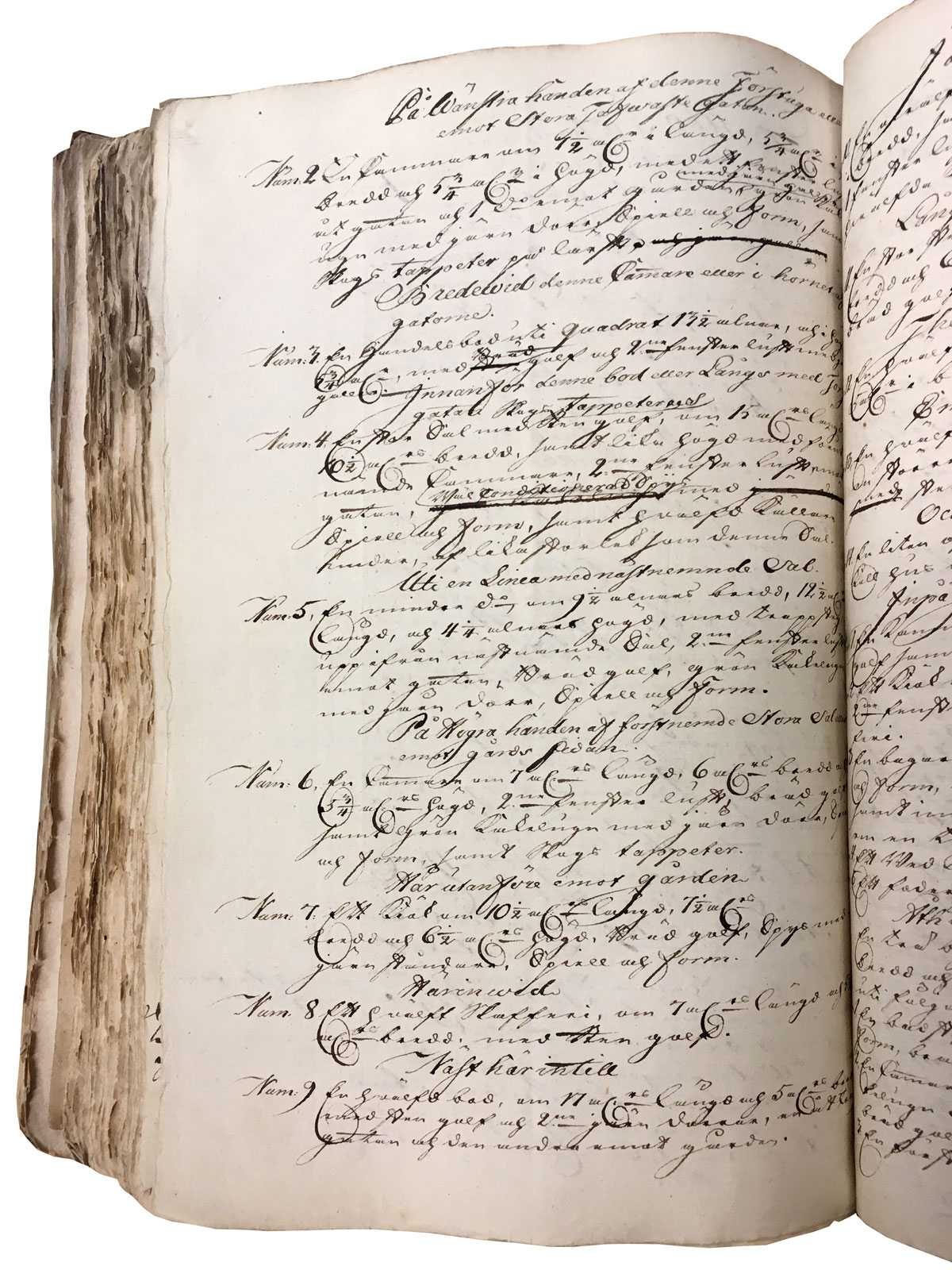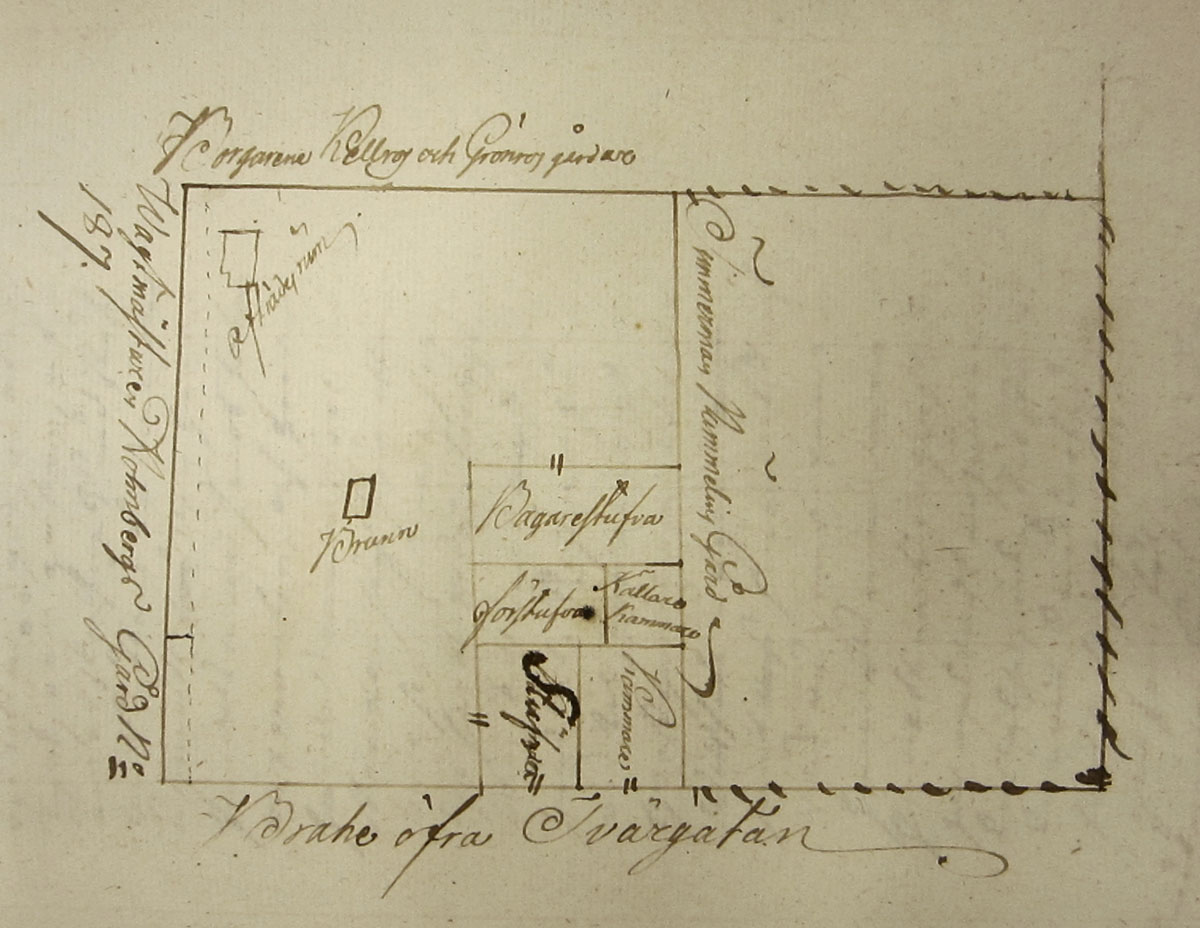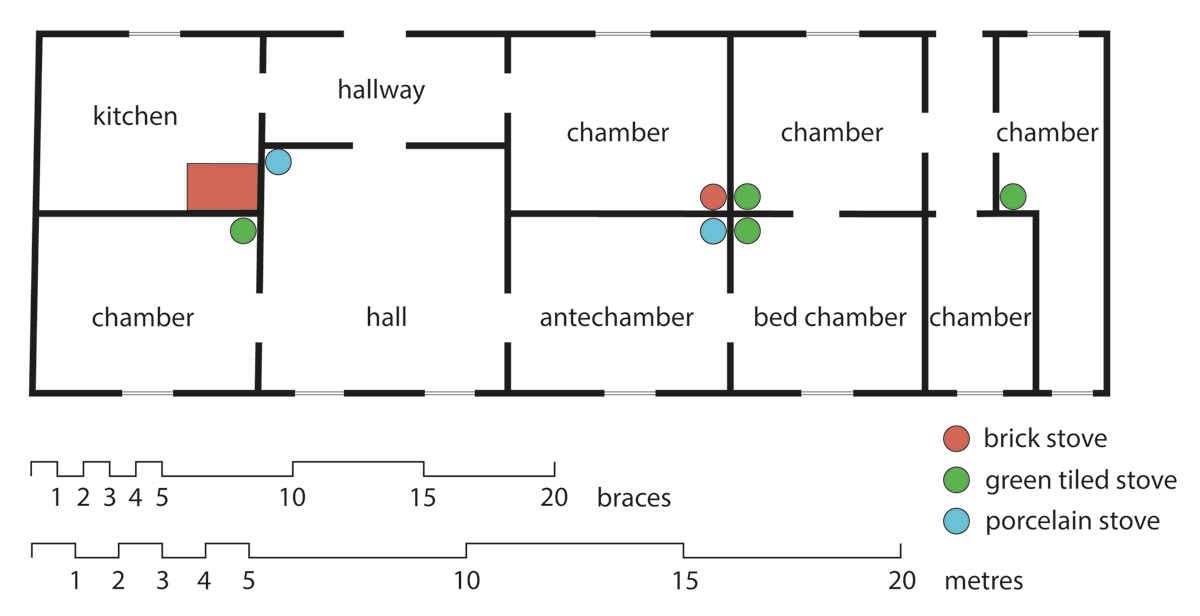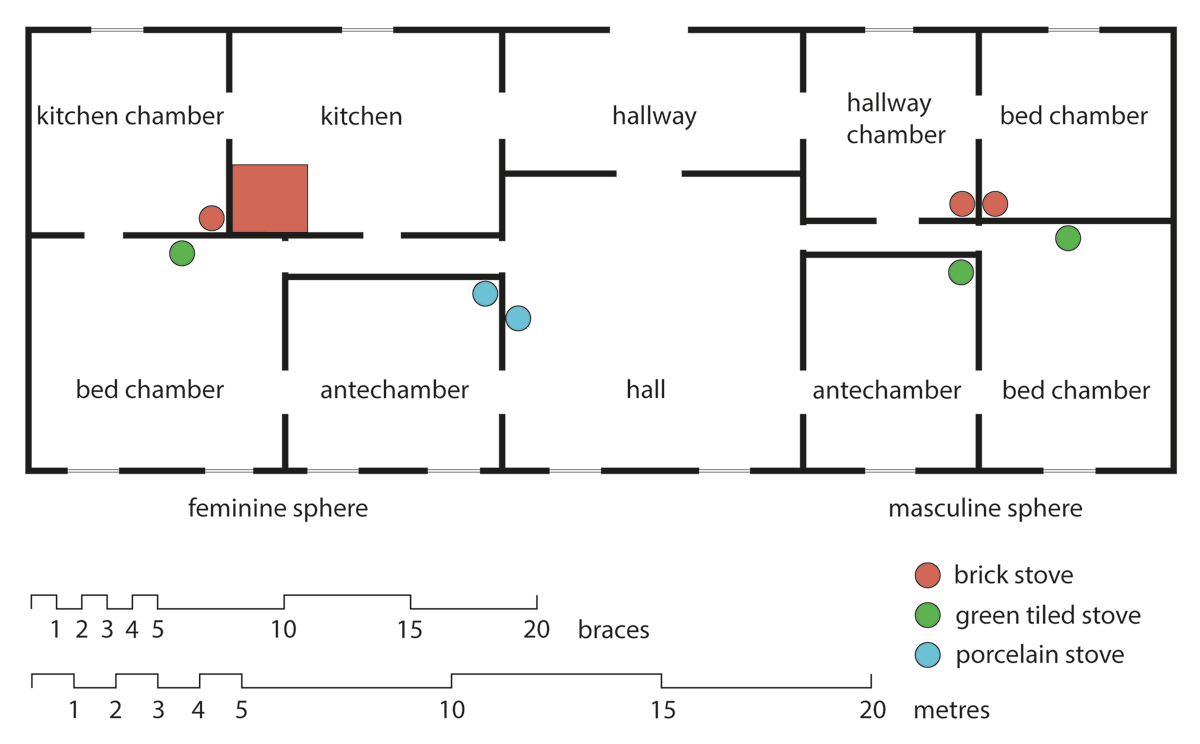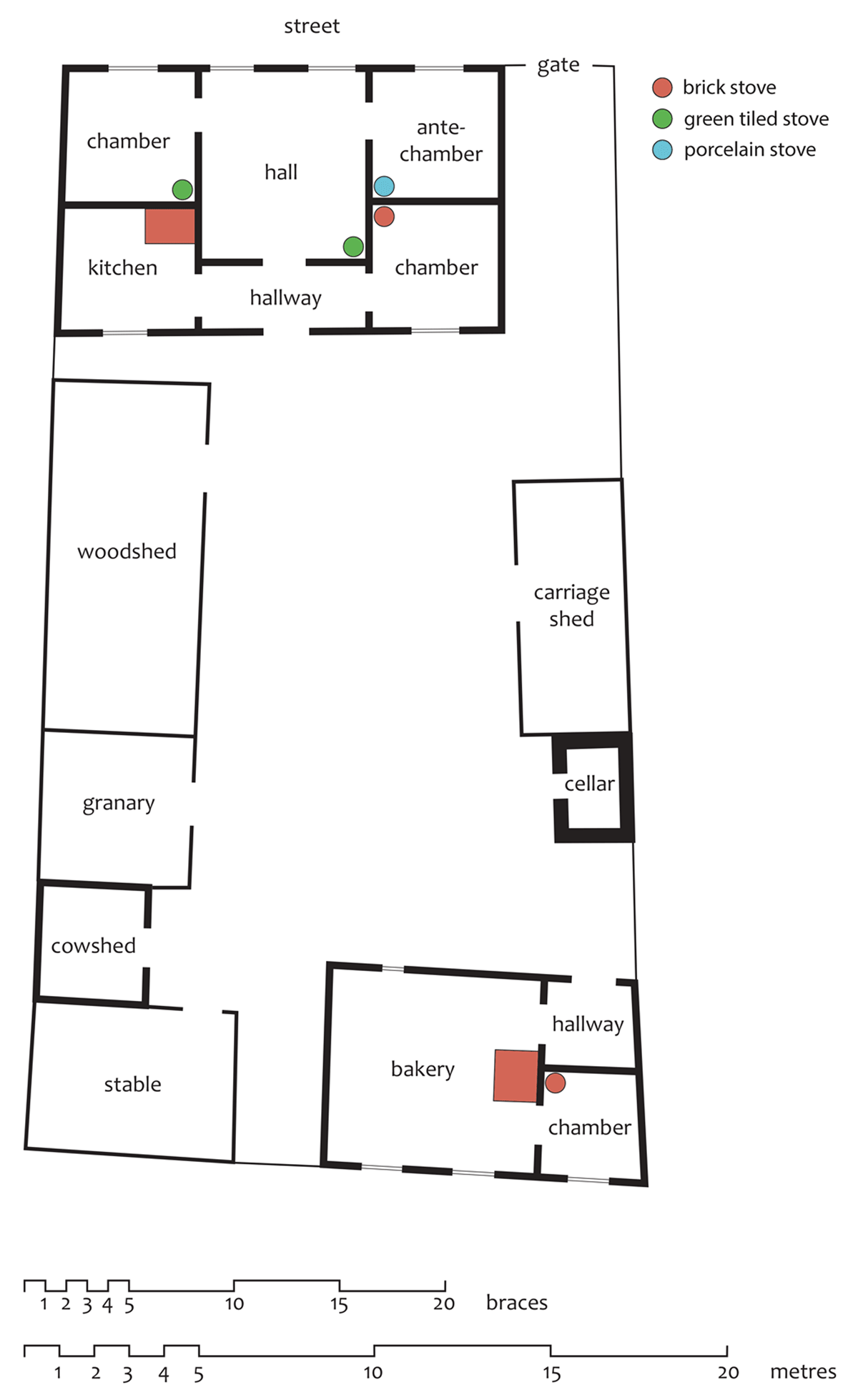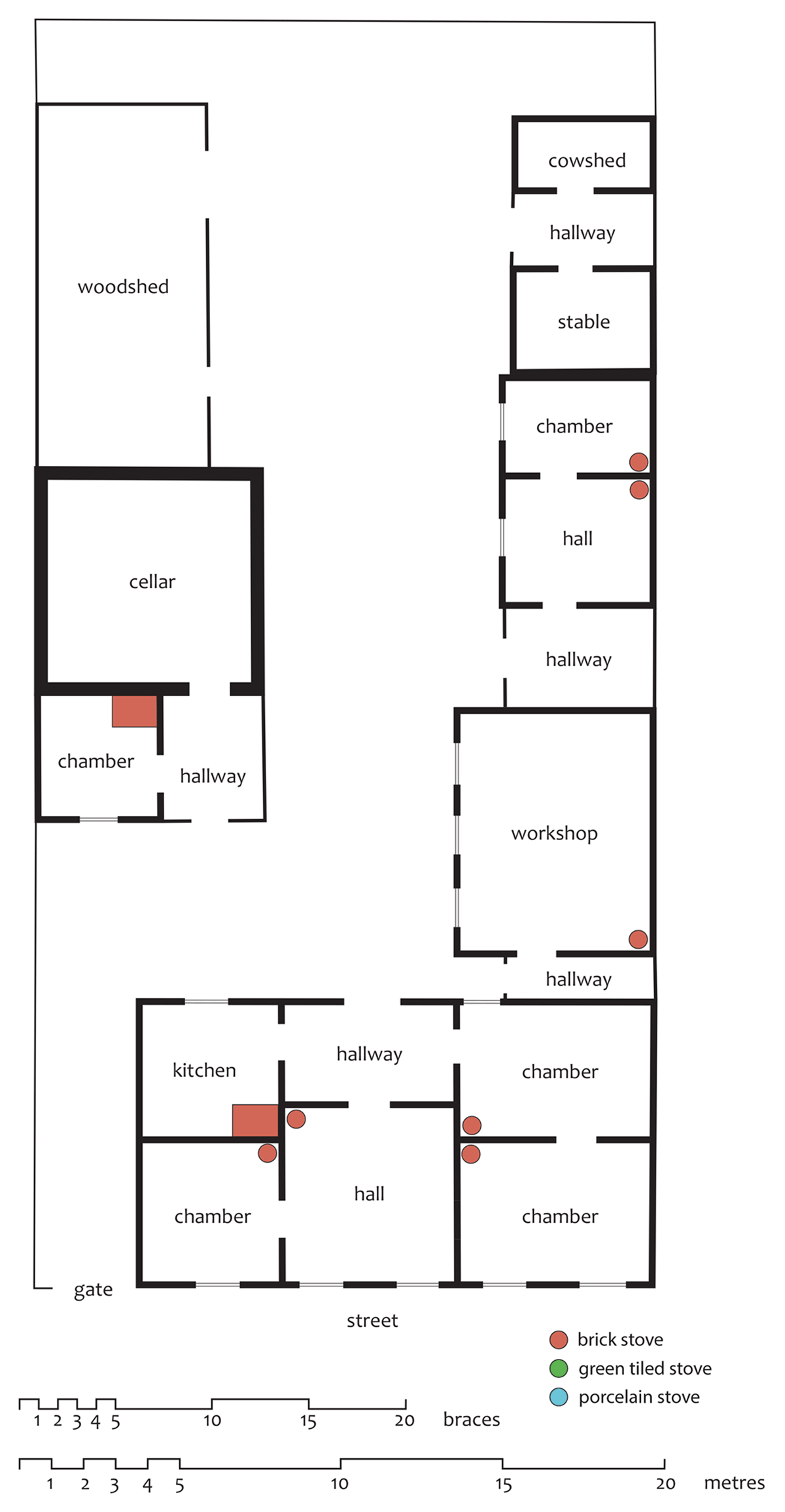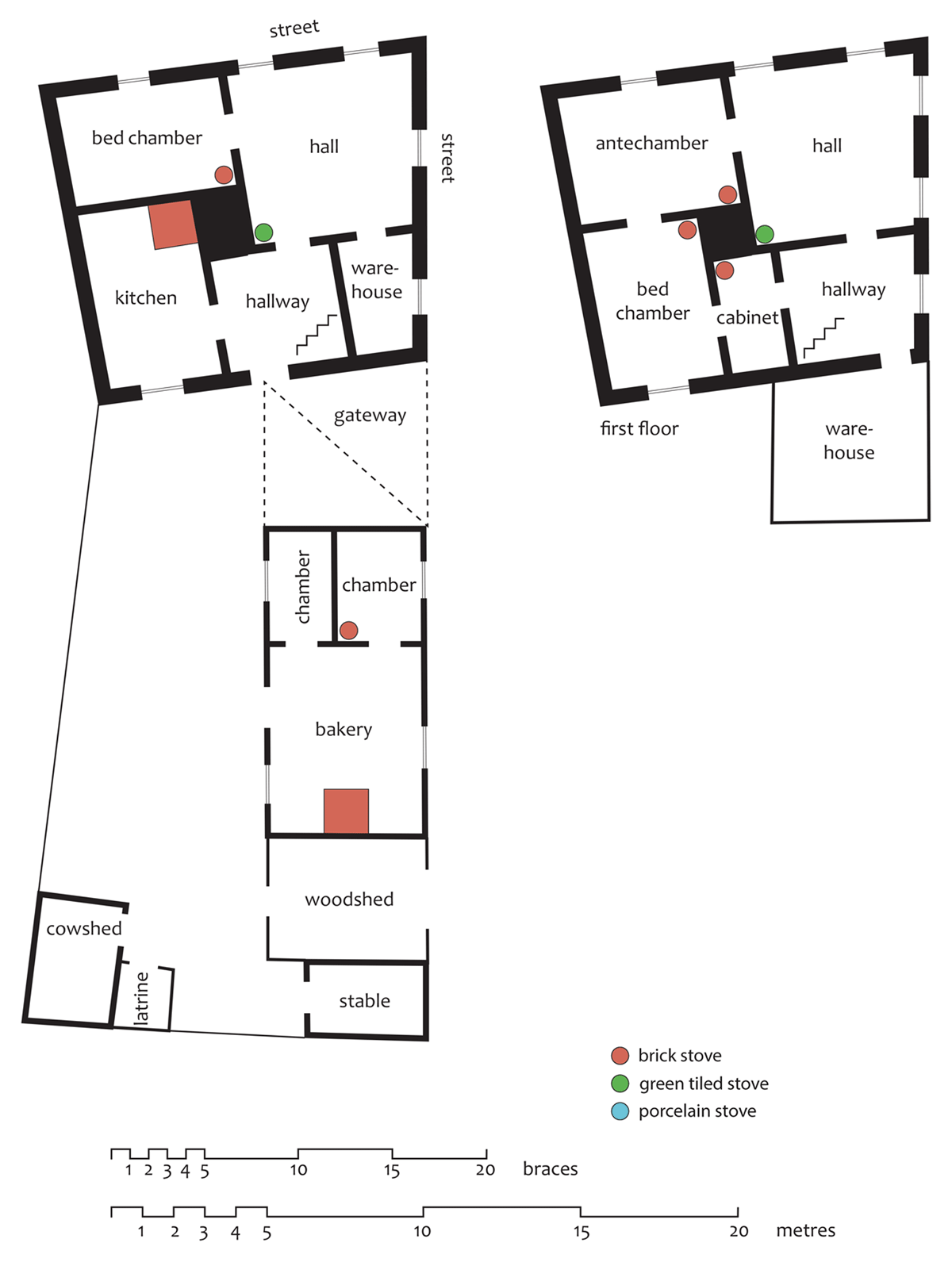Introduction
In September 1827, a calamitous fire almost completely destroyed the town of Turku (Åbo in Swedish), one of the largest towns on the northern shores of the Baltic Sea, with a population of around 13,000. Under the jurisdiction of the Russian empire since 1809, this former Swedish provincial town had become the capital of the Grand Duchy of Finland. The devastation was reported in newspapers worldwide, not least because of the loss of intellectual heritage, such as the collections of the academic library. In addition to medieval monuments, the fire destroyed nearly everything of the mostly wooden townscape of the Swedish era and ruined many masonry-built houses (Dahlström 1929; Salmi 2017; 2022).
The fire also wiped out the majority of the oeuvre of an architect of German origin, Christian Friedrich Schröder (1722–89). In the architectural historiography of Sweden and Finland, Schröder is mainly presented as the leading importer of French classicism to the scene of Finnish residential architecture (Nikander 1917; 1928), which he followed through literature published in Sweden (see Ulväng 2019; Ilmakunnas 2020). From 1756 until his death in 1789, he acted as the town architect of Turku and greatly shaped not only the architecture there but also the surrounding countryside. In a meticulous study of Schröder’s extant residential architecture, Riitta Koskinen (2012) sheds light on his career as the planner of high society manor houses, painting an overall picture of the classicist ideas of his residential architecture. A dozen surviving upper-class country estates help us imagine his work today.
Schröder’s residential designs for Turku were different, comprising hundreds of housing projects for all strata of the population. His urban dwellings are largely unknown, uncovered only in two remaining (almost completely altered) stone houses in Turku and five preserved architectural drawings. Because the fire destroyed not only the urban fabric but also much of the visual documents about it, we know little about the appearance of Schröder’s buildings.
Textual inventories are thus our primary access to Turku’s 18th-century townscape and material world. Visual reconstructions of (partially) destroyed sites have a long tradition in architectural history (e.g., Papy 2004; Piccoli 2017). Since the early modern era, vanished architecture has been resurrected in plan drawings, perspective images, and 3D models using archaeological data, architectural drawings, written documents, and imagination (Smiles and Moser 2005; Frischer 2008; Lulof 2020), but rather than focusing on ordinary urban buildings, the majority of the research and reconstructions cover monumental architecture and townscapes. In this article, I develop a reading of Schröder’s residential design using fire insurance policies and other surveys of buildings as my main source material. These Swedish-language descriptions of buildings and their properties date from the 1750s to 1807 (nearly all public documents in Finland were written in Swedish at the time).
To position Schröder’s architecture in a larger context of residential architecture in Europe at the time, I first provide a background of French classicism in Sweden through Schröder’s work, as well as Schröder’s career and his path to the North. Then I discuss the historical context of the fire insurance documents and other building surveys and inventories in 18th-century Sweden. I next explore the evidence of Schröder’s urban dwellings mined from the fire insurance documents in the context of his extant work and 18th-century urban residential architecture in general. Testing the usefulness of such bluntly written documentation for architectural history, my intention is to generate not only a richer picture of his work but also the Nordic scene of timber-built towns into which new fashions of residential architecture were adapted.
French Influences on Swedish Residential Architecture
Two of the few preserved — and verified — architectural drawings by Schröder are of a new residence (1777) and a retail and warehouse building (1779) for the household of the merchant Matthias Augustin, along the riverfront of Turku, designed during Schröder’s most active years as the town architect (Figures 1, 2). The house plan in Figure 1 follows the typical scheme of more affluent town dwellers, reminiscent of the enfilade of 18th-century Parisian apartments. The four most important rooms — the hall and three smaller chambers — face the street and the riverfront, while the kitchen and servants’ rooms are on the courtyard side. The names of the rooms do not appear in the drawing, but inventories of similar plans suggest that the rooms in enfilade contained one or two salons (förmak in Swedish) and a bed chamber. The façade of the stone-built retail and warehouse building has a simple rustication, but the residential house is a simple log structure, showing the traditional and main material of Finnish urban fabrics until the mid-20th-century.
The Parisian realm of residential architecture, with its reading rooms, children’s rooms, dressing rooms, and dining rooms, echoed throughout Europe at the time (see Neuman 1980; Dennis 1988; DeJean 2009; Davrius 2018; Figeac 2019; Eleb 2021). Printed architectural manuals circulated Parisian ideals to every corner of the continent. The manuals and collections of floor plans, such as Charles-Étienne Briseux’s Architecture moderne ou l’Art de bien bâtir (1728) and Jacques-François Blondel’s Maisons de plaisance (1737), Discours sur la nécessité de l’architecture (1754), and Architecture françoise ou recueil des plans, élévations, coupes et profils (1752–56), created a new culture of architectural publications. The leading theme of earlier treatises — decorative and aesthetic principles — came to be overridden by a focus on the functional arrangement of spaces (see DeJean 2011; Davrius 2018).
Similar manuals soon appeared in Sweden (Figures 3, 4). France greatly influenced the Swedish élite lifestyle in general (see Ilmakunnas 2014; 2017), whereas in the neighbouring Estonian and Livonian provinces of Russia, the German treatises (e.g., by Leonhard Christoph Sturm and later Friedrich Christian Schmidt) gained more popularity (see Maiste 2021: 123–127). During the first half of the 18th century, some Swedish architects had the opportunity to educate themselves in France, among them Carl Hårleman (1700–53), who became the chairman of the Public Buildings Office of the Kingdom of Sweden (Överintendentsämbetet) in 1741. The architects Carl Wijnblad and Carl E. Carlberg also followed attentively the contemporary French treatises (Wijnblad 1755–56; Wijnblad 1765; Wijnblad 1766; Erixon 1947; Alm 1986; 1993).
House plans with facades from the Swedish template book by Carl Wijnblad (1755–56: pl. 1). Drawings of facades are for masonry houses; for more modest houses, top plans are for masonry, bottom are for timber. Lund University Library.
House plans with facades from the Swedish template book by Carl Wijnblad (1755–56: pl. 6). Drawings of facades are for masonry houses; for more modest houses, top plans are for masonry, bottom are for timber. Lund University Library.
French ideals were adapted to the northern circumstances and building techniques by reducing the grandiose scale and attenuating the decorative motives. In addition, Wijnblad located the principal rooms on the first floor rather than the ground floor. In general, however, the same principles were followed in the Swedish homes as in French homes — comfort; rooms designated for specific activities; privacy; ‘feminine’ and ‘masculine’ spheres — that became a standard for upper-class residential design (Scott 1995; Ebeling 2004).
Schröder’s Path to Stockholm and Turku
Little is known of Schröder’s early journeyman itinerary of three years in Westphalia and Bohemia. From his own announcement of 1755 to Turku city officials, we know only that he held a journeyman certificate that was dated 1741 and given in Ebersberg (Gardberg 1963; Koskinen 2012: 73–74). In 1744, at the age of 22, Schröder arrived in the Stockholm, the capital of the Kingdom of Sweden. Despite his apprenticeship in the German lands, he seems to have been exposed to and followed mainly the French trends — indeed, influences from Paris resonated prominently in the circles of architects and master masons in Stockholm at the time (Ahnlund 1984; Alm 1986; Millhagen et al. 2000).
During his first years in Sweden, Schröder’s supervisor was the town architect of Stockholm, Carl E. Carlberg, whose private library possessed many of the key works of French architects. It was probably under his supervision that Schröder became familiar with these new trends (Ahnlund 1984). From 1751 to 1756, Schröder was the partner of a master mason, Pehr Westrell, in Stockholm. After Schröder completed his qualifying master work in 1755, he was forced to leave because of the lack of vacancies in the Stockholm master mason guild. But the magistrate of Turku, on the other side of the Gulf of Bothnia, lacked a professional town architect, and the representative of the municipality of Turku in the Swedish Diet, Christian Trapp, proposed on a visit to Stockholm that Schröder be appointed to the post (Koskinen 2012: 77–97, 104–106).
Turku, located on the southeastern coast of Finland, was a university town as well as a cathedral town, founded in the late 13th century, and a node of foreign and domestic trade. It was the third largest town in the Kingdom of Sweden (Hiekkanen 1997; Boerefijn 2010). During the 16th and 17th centuries, the urban area had grown far beyond its medieval core; agglomerations of houses for the lower classes in the rapidly expanding town area were climbing the hills encircling it (Figure 5). In the 1750s, the town was at the beginning of a period of rapid economic and demographic growth. The social topography reflected the townscape and urban structure: the most affluent houses were in the old core and along the banks of the river Aura (see Savolainen 2017).
The town of Turku, in a map from 1756 by land surveyor Daniel Gadolin. National Archives of Finland, Itu 6.
Schröder soon became a leading figure in the planning of public and private buildings in Turku, despite the local masons’ constant disapproval of him from the beginning. His architectural education was highly superior to that of all the local masters. University institutions for architectural education did not exist in 18th-century Sweden, but it is known that the term ‘architect’ was used for Schröder (Grange 2010). After several of his public projects had been realised in Turku in the early 1760s, the social class that had gained wealth during the favourable economic circumstances (mostly via sawmills and ironworks) found Schröder. These commissions have left the best-preserved standing examples of his residential design: Lapila (in Swedish, Ekstensholm, 1763), Fagervik (1773) (Figures 6, 7), Teijo (in Swedish, Tykö, early 1770s), Viksberg (early 1770s) (Figure 8), Lempisaari (in Swedish Lemsjöholm, 1767–74) (Figure 9), and Mustio (in Swedish, Svartå, 1782), from which still emanate classicist aesthetics and ideals (Koskinen 2012: 201–389; see Nikander 1928; Lounatvuori and Knapas 2005).
At the same time, around 1760, Schröder designed two remarkable projects in the center of Turku: the residence of the provincial governor and the complete renovation of the palace of the president of the court of appeal (Lehtonen 1996). Both still exist, although they were damaged in the fire of 1827; having been altered in several renovations, they carry almost no evidence of Schröder’s original design. Schröder also designed public buildings, such as the new spire of the medieval cathedral of Turku (1759) and the town hall of Rauma (in Swedish, Raumo, 1776).
In addition to his own work as an architect, Schröder’s legacy as an educator and instructor is important. As the leading figure of the stonemasons’ guild, he was responsible for the supervision of their masterpieces, the quality of which improved significantly after Schröder’s arrival; he was also responsible for spreading knowledge of Wijnblad’s manuals of 1755–56 and 1765 (see Gardberg 1963). Schröder’s influence is therefore visible in the history of the profession in Finland before the first educated architects, Carlo Bassi and Carl Ludvig Engel, arrived, in 1802 and 1814, respectively.
Schröder’s main field of work was, however, residential design for the middle and lower classes of Turku. His importance grew especially after the town fire of 1775, which induced the provincial governor, Christoffer Johan Rappe, to ask that Schröder rebuild the town. Rappe was not satisfied with the previously poor quality of design and drawings by stonemasons. As a result, between 1776 and 1786 Schröder had the exclusive right to design all the buildings erected in Turku (Dahlström 1929: 172–182; Gardberg 1963: 24; Koskinen 2012: 113–116).
As only a few architectural drawings bearing Schröder’s signature survive, the attribution of the design of the houses must be done using other means. We know that at least for that ten-year period, only drawings by Schröder could be accepted for acquiring a building permit from the town magistrate. Indeed, several drawings by master stonemasons (who could also be responsible for the design of timber buildings), all of them Schröder’s disciples, were rejected during those years. In addition, the Turku town court minutes from 1779–80 mention Schröder’s drawings for dozens of new houses (Koskinen 2012: 116, 121). Therefore, we can almost certainly assume that the houses under scrutiny here were made by Schröder’s hand. Just as we can attribute these buildings to Schröder with near certainty by examining tangential sources in the absence of actual records, so can we also learn what these houses looked like by examining written descriptions of them in the absence of the buildings themselves.
Written Descriptions of Buildings as Sources
In architectural history, inventories and metric descriptions are often used to reconstruct vanished architecture and interiors (e.g., Brown 1986; Melville 1999; Ulväng 1999; Overton et al. 2004; Baer 2008; Hohti 2010; Immonen 2012; Zobel 2014). Inventories and surveys in textual form have also played an important role in complementing the picture of the social and economic functions of buildings and interiors.
In the building survey material from the end of the 18th and beginning of the 19th centuries, extant visual documents about Turku are very scarce; instead, textual descriptions of the built environment dominate. This follows the general historical pattern of the late introduction of inventories in Sweden; elsewhere in Europe text-based inventories had become less rare towards the end of the 18th century (Riello 2021: 130, 140–141). The ‘visual turn’ in the representations and treatises of architecture and the advancements in the techniques of cartography also affected building surveys. However, the introduction of images and planimetric drawings did not immediately substitute for textual descriptions but led instead to the simultaneous expansion and enrichment of the accompanying texts (Friedman 2012: 287).
In the second half of the 18th century, visual and spatial information is thus transmitted almost exclusively through text in Turku (Figure 10), which still enables a careful examination of the built fabric and the stylistic and architectural flows, however. When the measurements of the buildings and rooms are comprehensively included, it becomes possible to reconstruct the basic features of the house in three dimensions in a relatively straightforward manner. The surveys allow the reconstruction of not only the various functions of rooms but also the details of construction materials and immovable furnishings: window sizes, type of tile stoves, external and internal colours, wallpaper, and style of locks. With the aid of information from early 19th-century town plans showing the outline of the plots (NAF, Itu 37), which are often irregular in form, it becomes possible to render the texts into planimetric or three-dimensional reconstructions of the built environment. The inventories provide much greater accuracy than descriptions in letters, travel diaries, or other similar sources. Furthermore, this material is a cross-section of the whole town community; unlike preserved architectural drawings, it enables an approach to the domestic architecture of all strata of urban society.
A survey for a compulsory auction of the buildings in the Church Quarter, plot no. 35, Turku. Turku City Archives, MA K6, 13 June 1760. Photo by Panu Savolainen.
Particularly useful are the building surveys made for compulsory auctions, the earliest of which, in Turku, date from the 1750s. The draftsmen of the surveys were town magistrate officials, who also had numerous other administrative roles. Between 1753 and 1827, approximately 500 surveys of town houses were conducted (TCA MA K6–K10), following the general pattern of inventories in 18th-century Sweden, even after 1809.
The earliest (extant) drawings are from in the mid-1770s, when magistrate officials began to occasionally furnish the survey documents with a rough site plan. The only extant house plan presenting an internal arrangement of rooms (Figure 11) is a fuzzy sketch on the verso side of the inventory document. It is dated 1793 and was, according to its placement and style, a way of presenting information that was secondary to text (TCA MA K6: 313v).
House plan sketch in a survey for a compulsory auction, 1793. Drawn by an unknown magistrate official. Turku City Archives, MA K8, 14 November 1793. Photo by Panu Savolainen.
Another important type of material for this study are the surveys conducted by the first nationwide fire insurance company of Sweden, beginning in 1785. Fire insurance policies originated in the aftermath of the Great Fire of London of 1666. Although planimetric drawings began to be added as supplementary information, text was the most important part of the documents until the 19th century (Åmark 1932; Clayton 1971; Reynolds and Ruwell 1975; Hawkings 2003). All of this seems to indicate that the evaluation of the buildings was based mainly on texts; plans were secondary documents. In Sweden the fire insurance surveys occasionally mention house plans enclosed with the documents, but only the textual descriptions have been preserved (TCA MA K16).
The fire insurance materials allow a detailed spatial reconstruction. They differ from other surveys because they consist of two separate descriptions. In an application for insurance, the house owner meticulously describes of all the property to be insured. The officials then inspected the houses and local agents of the Swedish royal insurance fund revised the application documents (usually the same officials from the town magistrate office who were responsible for the other building surveys). They reframed the description for the final approval of the insurance application at the insurance company headquarters in Stockholm (Åmark 1932: 1–40).
Adapting Classicist Ideals in Two Upper-Class Houses
The economic growth of the area and the accompanying expansion of Turku’s population, which more than doubled in the second half of the 18th century, had an enormous impact on the townscape. New trends of residential architecture appeared across all social strata of the population, and Schröder’s residential architecture represents a variety of new typologies. It also demonstrates how classicist residential architecture was adapted to the houses of the lower classes and especially to the local log construction technique.
The house of Commandant Carl Fredrik Rehbinder and Catharina Elisabeth Rehbinder (built in 1775, according to the fire insurance documents) along the riverfront in Turku is an example of the most complex type of log houses in the town (Figure 12). The house was insured in 1795 by Catharina, a widow by that time. The plan was based upon a progression of rooms from public to private: facing the public street, arranged in enfilade, are a chamber, hall, antechamber, and bed chamber (TCA MA K16, 15 May 1795). The rooms on the courtyard side formed the private sphere of the apartment, including a kitchen and the more private rooms. The most important rooms — the hall and the antechamber — were furnished with porcelain stoves, while the bed chamber and chamber had a green-glazed tile stove (worth approximately one third of the value of a porcelain stove). This hierarchy is similar to upper-class homes in Sweden in the second half of 18th century (Ilmakunnas 2016; Stobart and Prytz 2018: 241–242; Prytz 2020).
Reconstructed floor plan of Carl Fredrik and Catharina Elisabeth Rehbinder’s house of 1775, attributed to Christian Friedrich Schröder, destroyed by fire in 1827. The line indicating a wall at the bottom shows window openings that faced the street. The reconstruction was made according to fire insurance documents of 1795. Drawing by Panu Savolainen.
Typical for high society houses was the separate sphere for servants on the right side of the house. However, it was a novelty in the timber buildings of Turku, where servants normally lived in detached annexes (see Savolainen 2014). In the Rehbinder house, a separate entrance gave the owners of the house more privacy. This arrangement is exceptional among Schröder’s projects, since in his country houses a servant entrance was never realized, even though it appears in the drawings for the Fagervik and Mustio manors (Koskinen 2012: 227, 310). The fact that servant entrances were never built may have to do with the Finnish building tradition of providing only one entrance. However, the most significant aspect of the Rehbinder house is that Schröder implemented the idea of zones in his urban residential design — the plan reflects the controlled access to separate spheres of the house (cf. DeJean 2011: 40).
In the exemplary plan for another house by Schröder, built in 1782 for Eric Wallén, a judge in the court of appeal, and Anna Katarina Beckman (Figure 13), the layout was gendered (TCA MA K16, 28 March 1794; see Baxter 2010). The public sphere of the house, the bottom half of the plan, was divided symmetrically: on both sides of the main hall were the antechambers, and behind them the bed chambers of the master and mistress. This composition reflects the French appartements de parade (Scott 1995: 104–105), and follows a plan, with some modifications, from the manual of Carl Wijnblad (1755–56: Tab. VIII, Figure 4). The ‘feminine’ sphere, on the left, was exclusively furnished, with its own painted wallpaper and décor, as well as porcelain stoves, whereas the ‘masculine’ sphere was decorated more modestly — as instructed also in Blondel’s manuals (see Ollagnier 2006: 44). A clear indication of deliberate influences from French and Swedish manuals, and presumably also of Schröder’s hand in the design, were the corridors connecting the hall, bed chambers, and kitchen, which helped the servants move about without disturbing the privacy of their masters (see e.g. Wijnblad 1755–56: Tab. III, Figures 5 and 8, Tab. XXXI and XXXVII). This typical feature of the era, ubiquitous in the architectural manuals and floor plan prints (Davrius 2018), was a novelty in Finnish timber-built houses of the era. Again, similar solutions were utilized in Schröder’s country houses, such as Fagervik and Mustio (Koskinen 2012: 229, 309; see Nikander 1928).
Reconstructed floor plan of Eric Wallén and Anna Katarina Beckman’s house of 1782, attributed to Christian Friedrich Schröder, destroyed by fire in 1827. The line indicating a wall at the bottom shows window openings that faced the street. The reconstruction was made according to fire insurance documents of 1794. Drawing by Panu Savolainen.
Reflections of Classicism in Three Middle-Class Houses
Most houses in Turku were much more modest, however. While Schröder was able to fully express French ideals in the larger upper-class houses, his simpler designs followed a typical five-room central hall plan that was introduced to the Swedish élite in the late 17th century. Based on the template house plans promoted by the Kingdom of Sweden from 1687 onward, it was first used in official residences (Lounatvuori 1996). In Turku it was adopted by middle-class town dwellers in the late 18th century. Two distinct examples show attempts to create a similar division in a simpler scale, reflecting Schröder’s flexibility when using the central hall plan for different purposes and social contexts.
The plan of a house for the master bookbinder Henric Enberg, completed in 1782, focused around a central hall (Figure 14); it can be attributed to Schröder with certainty, since the town court minutes mention the drawings of Schröder two years before the house was finished (TCA MA P, 31 May 1780). The house was relatively confined by a narrow plot, contributing to a classicist hierarchy of rooms at its smallest scale. It was insured ten years after construction. The fire insurance documents reveal that the classicist ideals were also visible in the naming of the rooms as well as in interior decoration (TCA MA K16, 6 October 1792: 150–154v). A hall with an antechamber and a chamber flanking the street constituted the more prestigious enfilade in the ‘public sphere’ of the building. The tripartite hierarchy of importance of rooms was highlighted with tile stoves, whereas the antechamber had a more valuable porcelain stove, the hall and chamber green-glazed tile stoves, and the chamber on the courtyard side (perhaps used by the female servant) a modest brick stove. To the rear of the courtyard, a dwelling comprising a bakery and a chamber was erected at the same time, probably the domicile of the servants.
Reconstructed plan of Henric Enberg’s main house and outbuildings of 1782, designed by Christian Friedrich Schröder. Destroyed by fire in 1827. The line indicating a wall at the bottom shows window openings that faced the street. The reconstruction was made according to fire insurance documents of 1792. Drawing by Panu Savolainen.
Another house, this one for the interior decorator Gabriel Sweidell, finished in 1782, reflects a more austere realization of the classicist plan (Figure 15). Architectural drawings of this house were also definitely drawn by Schröder (TCA MAP, 8 February 1783). According to the fire insurance documents, it had modest brick stoves in all the rooms, which do not include an antechamber: all rooms besides the hall and kitchen were simply called chambers (TCA MA K16, 8 April 1795: 511–516v). It is possible that some of the larger chambers were used as craftsman workshops before Sweidell erected a larger workshop on the plot ten years later.
Stone and brick houses constitute another category in Schröder’s urban residential design, which in the densely built urban fabric form an interesting counterpart to the stone and brick manors still extant in the countryside. In 1757, the Swedish central government issued a statute that favored masonry building via tax exemptions, and this change also brought a number of commissions to Schröder (Dahlström 1929: 250–251).
An illustrative example is a stone house commissioned by furrier elderman Gustav Neppius in 1769 (Figure 16). Even though this house was built before Schröder was granted the exclusive right to design all the buildings in Turku, the floor plan and functions of the rooms imply his hand at work. The building was insured by a later owner of the house, Christina Krook (TCA MA K16, 11 October 1792: 155–161). The two-and-half-story masonry building was situated on a narrow corner plot that adopts the particular shape of two streets crossing at an acute angle. Instead of following a conventional plan with a central hall, the ground level comprised an apartment with a bed chamber and kitchen. The principal apartment was on the first floor, where the rooms could not be placed in enfilade; instead, they were arranged around the central flue in a sequence of a hall, an antechamber, a bed chamber, and a cabinet. On both floors the main halls were placed on the street corner, taking creative advantage of the limited spatial constraints (cf. Ebeling 2004: 101). Schröder was evidently modifying a similar plan from Wijnblad’s manual (1755–56: Tab. XXVI, Figure 2).
Reconstructed plan of the house, with outbuildings, originally commissioned by Gustav Neppius (1769) and refurnished in the ownership of Christina Krook (1792), attributed to Christian Friedrich Schröder. Destroyed by fire in 1827. The reconstruction was made according to fire insurance documents of 1792. Drawing by Panu Savolainen.
Although all these houses no longer exist, their plans, for both the upper and the middle classes, make it clear that Schröder’s designs in Turku form a worthy counterpart to his more luxurious country estates. The houses demonstrate the various commissioners’ residential typologies and Schröder’s attempts to instill the ideals of architectural manuals in different scales.
Designs for the Lower Classes: Northern Aningais Quarter
In addition to the single houses in different parts of Turku, Schröder’s impact on the townscape can be studied through the redesign of one whole quarter, after over 150 houses burned down in the fire of 1775 (Nikula 1970: 63–69). The subsequent redesign of the Northern Aningais (Aninkainen in Finnish) Quarter was for residential architecture, in the form of log houses, for the middle and lower classes (journeymen, craftsmen, widows, etc.) in particular.
Rebuilt between 1776 and 1779, this quarter bears a significant imprint of Schröder’s modest residential design. No visual testimony remains, except for one drawing from 1776 (Figure 17), since the quarter was completely destroyed in the fire of 1827. However, a series of documents about the newly built plots unveils at least some of the vanished urban fabric. These documents, in which the descriptions of 40 houses survive, are surveys, probably made to record the progress of the rebuilding of the quarter (TCA MA K7, 6–10 April 1779, and 16–18 August 1779: 215–222).
Unlike other houses in parts of the town where timber and turf roofs dominated (Savolainen 2017), nearly all the main buildings in this quarter were roofed with cobblestone shingles, aligning with Governor Rappe’s goal to prevent fires (Dahlström 1929: 274–276). The reconstruction was indeed organized by the forceful governor, who throughout his tenure claimed the need for more spacious streets and a more organized pattern of buildings. The rebuilding of this quarter provided an opportunity to realize these principles in a central location, not far from the cathedral. Drawings were proclaimed obligatory for obtaining building permits for this area. The buildings erected, mostly of one story, were relatively uniform and their architectural character was modest. It is perhaps this homogenous townscape that aroused the admiration of several contemporaries, such as Carl Fredric Fredenheim, a remarkable enthusiast of fine arts and architecture in late 18th-century Sweden (Dahlström 1929: 212; Nikula 1970: 80).
Later surveys for the same plots allow a more accurate glimpse at the house plans of the Northern Aningais Quarter. The house of butcher Henric Wialén, for example, was designed in 1782 (TCA MA K16, 3 October 1795: 584–589v). The survey says that main building, painted with red ochre, comprised a hall, chamber, antechamber, and bed chamber, as did the more affluent houses in the town. The most exquisitely furnished room was the antechamber, with its green-glazed tile stove and oil-painted wallpapers. The other rooms had brick stoves, simpler wallpapers or none at all. Only the main building had modern windows, in six windowpanes, whereas the rest of the residential and outbuildings had old-fashioned lead-framed windows with tiny panes.
Another example from the quarter is a house built by sea customs inspector Anders Wahlström in 1776 (another residential building was added on the plot in 1783). This house is interesting due to its unusual plan (Figure 18). The census records reveal a large number of lodgers on the plot, and it seems that ease of renting out individual chambers, achieved through the social flexibility of the spatial arrangements, was intended from the beginning. In particular, the plan of the building facing the street seems to be designed to produce two separate apartments that could use the shared kitchen independently.
Conclusion
The almost imageless nature of the building record in 18th-century Turku is noteworthy. In comparison to the well-documented explosion of images and visual representations of architecture in the metropoles of the early modern world, the case of the mid-sized Northern European town of Turku offers an example of the persistence of purely textual building surveys supported by very little visual material, not even house plans. Among the hundreds of surveys made for the purposes of the town administration and auctions, only one contains a floor plan, and even that shows only the most basic disposition of rooms. While from 1785 onward, fire insurance documents were furnished with house plans, these too have been lost.
The destruction of the majority of Christian Friedrich Schröder’s oeuvre in the Great Fire of Turku in 1827 has distorted the bigger picture of his architectural career. His residential designs in Turku allow us to uncover a more general phenomenon in architectural history. Whereas architects are mainly remembered by their extant and often more spectacular buildings, marginal textual sources may in fact reveal a great deal about humble, and even completely vanished, types of buildings. The material from Turku provides an example of the remote entanglements of continental developments in architecture with local construction techniques and local circumstances. Schröder’s professional itinerary from Bohemia to Finland, via Sweden, is one of the numerous examples of the transnational careers of architects and builders in the 18th century. His design of country houses is a testimony of how the nuances and novelties of France were adopted first in Stockholm and then in more distant areas of the kingdom, including southwest Finland.
Whereas Schröder’s manors reflect the demands and architectural fashion of affluent clients, the examination of his vanished oeuvre, chartable through fire insurance records and other textual surveys, brings to light his more commonplace work: over three decades, the majority of Schröder’s designs was in fact for Turku, and consisted mainly of relatively modest log houses. Nevertheless, the few surviving architectural drawings, together with archival material, provide valuable new insights into how classicist residential house plans and interiors were adapted to a local scale. The more affluent houses in Turku show how architectural ideas in manuals from France and Sweden — the gendering of the house plans, specific functions and naming of rooms, and separate spaces for masters and servants — were instilled into the designs of local timber-built houses. The same basic principles were simplified and extended to different scales of log houses, such as rental houses.
The documentary evidence from Turku of the late 18th and early 19th century thus explains the echoing and reflection of French architectural ideas from European centres in the ordinary residential architecture of small provincial towns. Architectural innovations in Sweden were transmitted through books and drawings and through the ways that architects realized ideas they had experienced — or only read about — in the metropolises of Europe. Schröder’s oeuvre shows, on the one hand, how such architects were able to fully express these ideas with affluent clients in their manor estates and the most affluent town-dwellers. On the other hand, in Schröder’s work as a town architect, the most important clients were from the middle and lower classes — the part of Schröder’s legacy that is preserved almost exclusively in textual sources and has not been studied until now.
Author’s Note
The research for this article was funded by a grant from the Svenska litteratursällskapet i Finland.
Competing Interests
The author has no competing interests to declare.
References
Unpublished Sources
NAF. National Archives of Finland, Helsinki. Maanmittaushallituksen uudistusarkisto, kaupunkikartat [Reform archive of the National Land Survey board of Finland, city maps]
Itu 6. Land survey of Turku by Daniel Gadolin, 1756.
Itu 37. Land survey of Turku by Johan Tillberg, 1818.
TCA. Turku City Archives
MA K6. Maistraatin alaisten toimielinten arkisto, katselmuskirjat [Magistrate surveys of real estate and buildings]. Mätnings, Faste och Köpebref [Surveys, land certificates and muniments], 1742–75.
MA K7. Syne och Mätnings Instrument [Inspection and survey protocols], 1776–85; K8, 1784–93; K9, 1794–1802; K10, 1803–09.
MA K16. Brandförsäkringsinstrument [Fire insurance policy surveys and protocols], 1785–98; K17, 1799–1807.
MA P. Maistraatin pöytäkirjat [Town court minutes], 1780, 1783.
Published Sources
Ahnlund, H. 1984. Johan Eberhard Carlberg. Stockholms stads arkitekt 1727–1773 [Stockholm’s city architect, 1727–1773]. Stockholm: Stockholm Liber.
Alm, G. 1986. Svensk klassicism [Swedish classicism]. Lund: Signum.
Alm, G. 1993. Carl Hårleman och den Svenska rokokon [Carl Hårleman and the Swedish rococo]. Lund: Signum.
Åmark, K. 1932. Allmänna brandförsäkringsverket 1782–1932. Minneskrift [Public Fire Insurance Agency 1782–1932. A History]. Stockholm: Allmänna Brandförsäkringsverket.
Baer, W. 2008. Housing for the Lesser Sort in Stuart London: Findings from Certificates, and Returns of Divided Houses. The London Journal, 33(1): 61–88. DOI: http://doi.org/10.1179/174963208X270597
Baxter, D. 2010. Introduction: Constructing Space and Identity in the Eighteenth-Century Interior. In: Baxter, D and Martin, M (eds.), Architectural Space in Eighteenth-Century Europe: Constructing Identities and Interiors, 1–14. Burlington: Ashgate.
Boerefijn, W. 2010. The Foundation, Planning and Building of New Towns in the 13th and 14th Centuries in Europe: An Architectural-Historical Research into Urban Form and its Creation. Amsterdam: University of Amsterdam.
Brown, FE. 1986. Continuity and Change in the Urban House: Developments in Domestic Space Organisation in Seventeenth-Century London. Comparative Studies in Society and History, 28(3): 559–567. DOI: http://doi.org/10.1017/S0010417500014079
Clayton, G. 1971. British Insurance. London: Elek Books.
Dahlström, S. 1929. Åbo Brand 1827: Studier i Åbo Stads Byggnadshistoria intill 1843. [The Fire of Turku 1827: Inquiries on the building and construction in Turku until 1843]. Åbo: Bidrag till Åbo stads historia 14.
Davrius, A. 2018. Jacques-François Blondel, architecte des Lumières. Paris: Classiques Garnier. DOI: http://doi.org/10.15122/isbn.978-2-406-07286-7.p.0027
DeJean, J. 2009. The Age of Comfort: When Paris Discovered Casual — and the Modern Home Began. New York: Bloomsbury.
DeJean, J. 2011. A New Interiority: The Architecture of Privacy in Eighteenth-Century Paris. In: Bremer-David, C (ed.), Paris: Life and Luxury in the Eighteenth-Century, 33–52. Los Angeles: Getty Publications.
Dennis, M. 1988. Court and Garden: From the French Hôtel to the City of Modern Architecture. Massachusetts: MIT Press.
Ebeling, J. 2004. Habitat et structure sociale au XVIIIe siècle. La maison Bergeret. In: Dubois, I, Gady, A and Ziegler, H (eds.). Place des Victoires: Histoire, architecture, société. Paris: Centre Allemand d’Histoire de l’Art. pp. 94–105.
Eleb, M. 2021. Naissance et évolution des espaces de l’intime en France. Journal of the Society of Dix-Neuviémistes, 25(1): 99–110. DOI: http://doi.org/10.1080/14787318.2021.1926873
Erixon, S. 1947. Svensk byggnadskultur [Swedish culture of building]. Stockholm: Bokverk.
Figeac, M (ed.). 2019. L’Habitat des élites urbaines en Europe à l’époque moderne. Pessac: Maison des Sciences de l’Homme d’Aquitaine. DOI: http://doi.org/10.4000/books.msha.20286
Frischer, B, and Dakouri-Hild, A (eds.). 2008. Beyond Illustration: 2d and 3d Digital Technologies as Tools for Discovery in Archaeology. Oxford: Archaeopress. DOI: http://doi.org/10.30861/9781407302928
Friedman, F. 2012. Visual Documents, Property Archives, and the Map of the City of Rome: 1563–1712. Journal of the Society of Architectural Historians, 71(3): 279–305. DOI: http://doi.org/10.1525/jsah.2012.71.3.278
Gardberg, C. 1963. Turun muurarimestarit ja heidän mestarintyönsä 1721–1859 [The master masons of Turku and their masterpieces, 1721–1859]. Turun kaupungin historiallisen museon vuosijulkaisu, 26–27(1): 3–63.
Grange, K. 2010. Mellan skrå och profession. Om de Svenska arkitekt- och ingengörutbildingarnas framväxt och hur ett dominerande kunskapsideal hart tagit form [Between craft and profession. Remarks on the education of architects and engineers, and how leading ideals have taken shape in Sweden]. FORMakademisk, 3(2): 26–38. DOI: http://doi.org/10.7577/formakademisk.109
Hawkings, D. 2003. Fire Insurance Records for Family and Local Historians. London: Francis Boutle Publishers.
Hiekkanen, M. 1997. Die Gründung der Stadt Turku. In Mugurevics, E and Ose, I (eds.), Civitas et castrum ad Mare Balticum, 157–177. Riga: Latvijas Vēstures institūts.
Hohti, P. 2010. Domestic Space and Identity: Artisans, Shopkeepers and Traders in Sixteenth-Century Siena. Urban History, 37(3): 372–385. DOI: http://doi.org/10.1017/S0963926810000519
Immonen, T. 2012. Building the Cassinese Monastic Identity: A Reconstruction of the Fresco Program of the Desiderian Basilica (1071). Helsinki: University of Helsinki.
Ilmakunnas, J. 2014. Högadeln bor i staden. Fersenska palatset som urbant mikrokosmos I Stockholm ca. 1740–1795 [High society in town. The palace of Fersen family as an urban microcosm in Stockholm, ca. 1740–1795]. Bebyggelsehistorisk tidskrift, 68(1): 8–25.
Ilmakunnas, J. 2016. To Build According to One’s Status: The Country House in Late 18th Century Sweden. In Stobart, J and Hann, A (eds.), The Country House, 33–42. Material Culture and Consumption. London: Historic England.
Ilmakunnas, J. 2017. French Fashions: Aspects of Elite Lifestyle in Eighteenth-Century Sweden. In Ilmakunnas, J, and Stobart, J (eds.), A Taste for Luxury in Early Modern Europe: Display, Acquisition and Boundaries, 243–264. London: Bloomsbury. DOI: http://doi.org/10.5040/9781474258265.ch-012
Ilmakunnas, J. 2020. Northern Comfort and Discomfort: Spaces and Objects in Swedish Country Houses, c. 1740–1800. In: Stobart, J (ed.), The Comforts of Home in Western Europe, 1700–1900, 45–66. London and New York: Bloomsbury. DOI: http://doi.org/10.5040/9781350092983.0010
Koskinen, R. 2012. Kartanot ja virkatalot Turun kaupunginarkkitehti Christian Friedrich Schröderin tuotannossa [Manors and official residences in the works of Turku city architect Christian Friedrich Schröder]. Turku: Annales Universitatis Turkuensis.
Lehtonen, K. 1996. Turun hovioikeudenpresidentin ja maaherran virkatalo 1730–1827 [The official residence of the president of court of appeal and general governor of Turku, 1730–1827]. Aboa, 1991–1992: 76–109.
Lounatvuori, I. 1996. Mallin mukaan maan tavalla. Mallipiirustukset ja sotilasvirkatalojen rakentaminen 1687–1810 [Following the models, following the tradition. Manuals and official residences of the army, 1687–1810]. Helsinki: Museovirasto.
Lounatvuori, I, and Knapas, M. Louhisaaren kartano. Suku ja rälssi — säteri ja kirkko [Louhisaari manor. Family and nobility — manor and the church]. Helsinki: Museovirasto.
Lulof, P. 2020. Recreating Reconstructions: Archaeology, Architecture and 3D Technologies. In: Dupré, S et al. (eds.), Reconstruction, Replication and Re-enactment in the Humanities and Social Sciences, 253–274. Amsterdam: Amsterdam University Press. DOI: http://doi.org/10.1515/9789048543854-011
Maiste, J. 2021. Hiiu-Suuremõisa and Kolga. Two Manor Ensembles of the de la Gardie and Stenbock Families in the Mirror of the 17th–18th Century Noble Culture. Baltic Journal of Art History, 22(1): 71–141.
Melville, JD. 1999. The Use and Organisation of Domestic Space in Late Seventeenth-Century London. Cambridge: University of Cambridge.
Millhagen, R, Olausson, M, and Alm, G. 2000. Carl Hårleman: människan och verket [Carl Hårleman: The man and his work]. Stockholm: Nationalmuseum.
Nikander, G. 1917. Finländska herrgårdar under den gustavianska tiden [Finnish neoclassical manors]. Helsinfors: Historiska Föreningen.
Nikander, G (ed.). 1928. Herrgårdar I Finland [Finnish manors]. Helsingfors: Söderström.
Nikula, O. 1970. Turun kaupungin historia 1721–1809 [History of Turku, 1721–1809]. Turku: Turun kaupunki.
Neuman, R. 1980. French Domestic Architecture in the Early 18th Century: The Town Houses of Robert de Cotte. Journal of the Society of Architectural Historians, 39(2): 128–144. DOI: http://doi.org/10.2307/989581
Ollagnier, C. 2006. Architecture au féminin: le cas de l’hôtel parisien du XVIIIe siècle (1700–1750). Histoire de l’art, 59(1): 41–50. DOI: http://doi.org/10.3406/hista.2006.3155
Overton, M, et al. 2004. Production and Consumption in English Households, 1600–1750. New York: Routledge. DOI: http://doi.org/10.4324/9780203644775
Papy, J. 2004. An Antiquarian Scholar between Text and Image? Justus Lipsius, Humanist Education, and the Visualization of Ancient Rome. The Sixteenth Century Journal, 35(1): 97–131. DOI: http://doi.org/10.2307/20476840
Piccoli, C. 2017. Visualizing Antiquity before the Digital Age: Early and Late Modern Reconstructions of Greek and Roman Cityscapes. Analecta Praehistorica Leidensia, 47: 225–257. DOI: http://doi.org/10.2307/j.ctv1zcm26w
Prytz, C. 2020. The Improved Tiled Stove: Sweden’s Contribution to Defining Comfort? In Stobart, J (ed.), The Comforts of Home in Western Europe, 1700–1900, 93–98. London: Bloomsbury. DOI: http://doi.org/10.5040/9781350092983.0013
Reynolds, R, and Ruwell, M. 1975. Fire Insurance Records: A Versatile Resource. The American Archivist, 38(1): 15–21. DOI: http://doi.org/10.17723/aarc.38.1.p5408x1h74n267w8
Riello, G. 2021. Things Seen and Unseen: The Material Culture of Early Modern Inventories and their Representation of Domestic Interiors. In: Findlen, P (ed.), Early Modern Things: Objects and their Histories, 1500–1800, 125–150. London: Routledge. DOI: http://doi.org/10.4324/9781351055741-8
Salmi, H. 2017. Catastrophe, Emotions and Guilt: The Great Fire of Turku, 1827. In: Simonton, D and Salmi, H (eds.). Catastrophe, Gender and Urban Experience 1648–1920, 121–138. London and New York: Routledge. DOI: http://doi.org/10.4324/9781315522814
Salmi, H. 2022. Tunteiden palo. Turku liekeissä 1827 [The fire of emotions. Turku in flames 1827]. Helsinki: Otava.
Savolainen, P. 2014. Tirkistelyä förmaakeihin ja ylishuoneisiin. Turkulaista asumista kahden vuosisadan takaa [Peering into salons and attics. Late 18th and early 19th century housing in Turku]. Turku: Turun museokeskus.
Savolainen, P. 2017. Teksteistä rakennettu kaupunki, julkinen ja yksityinen tila turkulaisessa kielenkäytössä ja arkielämässä 1740–1810 [A textually built city. Public and private space in linguistic practices and everyday life in Turku, 1740–1810]. Turku: Sigillum.
Scott, K. 1995. The Rococo Interior: Decoration and Social Spaces in Eighteenth-Century Paris. New Haven: Yale University Press.
Smiles, S, and Moser, S (eds.). 2005. Envisioning the Past: Archaeology and the Image. Malden: Wiley-Blackwell. DOI: http://doi.org/10.1002/9780470774830
Stobart, J, and Prytz, C. 2018. Comfort in English and Swedish Country Houses, c. 1760–1820. Social History, 43(2): 234–258. DOI: http://doi.org/10.1080/03071022.2018.1426279
Ulväng, G. 1999. Syneprotokoll, mantalslängd och brandförsäkringar: äldre skriftliga källor om den uppländska bondebebyggelsen [Survey documents, censuses and fire insurance policies: Older written documents and vernacular construction in Uppland]. Upplands fornminnesförenings förlag, 1999: 73–94.
Ulväng, G. 2019. The Swedish Manor 1750 to 1950. In: Finch, J, Dyrmann, K and Frausing, M (eds.), Estate Landscape in Northern Europe, 97–128. Aarhus: Aarhus University Press.
Wijnblad, C. 1755–56. Byggningskonsten. Ritningar på fyratio wåningshus af sten och trettio af träd samt åtskilliga lusthus mm [Drawings of 40 stone housing blocks and 30 timber houses with several pavilions]. Stockholm.
Wijnblad, C. 1765. Generalplaner til fem sätesgårdar [Design for five manors]. Stockholm.
Wijnblad, C. 1766. Beskrifning huru allmogens byggnader så af sten som träd måge med största besparing uppföras [Description of spare construction for stone and timber buildings for the lower classes]. Stockholm.
Zobel, R. 2014. Tallinn (Reval): Fortifications in the Middle Ages. Tallinn: Eesti Kunstiakadeemia.
